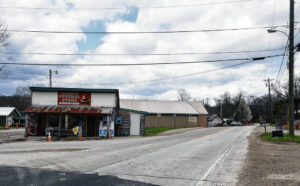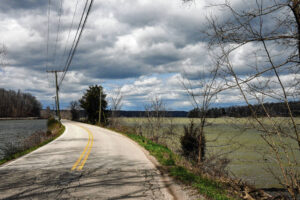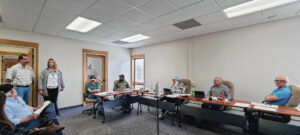Nearly $800,000 of COVID-19 relief funding will be allocated to help support two projects that aim to expand sewer service in the northern part of the county.
The requests for American Rescue Plan Act funding from the Brown County and the Helmsburg regional sewer districts were initially made at the Feb. 2 Brown County Commissioners meeting.
Last year it was announced that Brown County would receive nearly $3 million in relief funding from ARPA to help with the local response to the COVID-19 pandemic.
Local governments can use the money for a number of expenses, including revenue shortfalls; responding to negative impacts on housing, nonprofits and small businesses due to the pandemic; paying salaries of essential workers; paying for necessary investments in water, sewer or broadband infrastructure; or capital investments in public facilities to meet pandemic operational needs.
The ARPA money was split into two payments. The county received its first payment last summer totalling around $1.4 million. The second round of funding is expected to arrive this summer.
The commissioners approved both requests at their meeting last week as part of the $1,440,000 appropriation from the ARPA fund they will ask the Brown County Council to approve later this month.
Brown County Regional Sewer District requested $300,000 to support a wastewater infrastructure project that would provide sewer services to residents and businesses in Bean Blossom, along the State Road 45 corridor and the east end of the Lake Lemon area.
The plan is to connect the existing sewer project area in Bean Blossom, including Woodland Lake, to the Lake Lemon area and then study how wastewater from both of those areas can be transported to the Helmsburg sewer plant.

Funding would be used to combine already completed engineering and environmental studies along with rate and easement assessments from both the Bean Blossom and Lake Lemon areas to find a way to bring that waste to Helmsburg, BCRSD board member Clint Studabaker explained at the April 6 commissioners meeting.
Helmsburg Regional Sewer District requested $515,000 of ARPA funds to help a three phase project in that area. Parts of that request have already been approved.
Last December, the commissioners approved giving $25,000 in ARPA funding to HRSD. The money was used to purchase property to expand the sewer plant in Helmsburg, which was part of phase one of the project to expand service there.
HRSD now owns between two-and-a-half to three acres. The board also has $3,869 left from the $25,000 that it is keeping until it can be allocated elsewhere, board member Kyle Myers said in February.
Another part of phase one was hooking two new customers onto the main Helmsburg sewer line who are just outside of the service area, which was estimated to cost $40,000. Those two new customers have either a failing septic system or want to be on the sewer system so they can expand their home. The commissioners approved that portion of Helmsburg’s funding request at their March 23 meeting.
Following those approvals HRSD’s remaining request is $450,000. Of that request, $75,000 would be used for a preliminary engineering report on how the plant in Helmsburg can be expanded in conjunction with what BCRSD is doing to take on additional wastewater from Bean Blossom and Lake Lemon.
This work is being done to help bring down costs for current Helmsburg sewer customers who are paying $92.50 a month for sewer service, Myers said.
“We can’t keep nickeling and diming our current users. We’re basically pretty much operating at a break even,” Myers said in February.
Currently HRSD has around 60 customers on their system. The plant can take in 25,000 gallons of wastewater per day and is operating at 50% capacity, so there is potential to add 30 to 40 more customers before expanding the plant is necessary, Myers said.

In March 2020 a report was released following a study by Ethel Morgan of HomeTown Engineering. Morgan that studied seven different options or combinations of options to provide sewer service to the Bean Blossom and Trevlac/Lake Lemon areas. Getting sewer service to Bean Blossom has been in development for over 20 years.
If the Helmsburg plant was going to expand to take on sewer flow from the Bean Blossom and Lake Lemon areas it would have to be able to take in around 140,000 gallons a day, per Morgan’s report.
A summary of her 194-page “Preliminary Engineering Report for the Regionalization Assistance Program” was presented in March 2020 before BCRSD and HRSD boards, as well as about 20 other people, many from the Lake Lemon and Helmsburg areas.
Using numbers from Morgan’s report, the price tag to collect and treat wastewater from the Bean Blossom and Lake Lemon areas to transfer to the Helmsburg plant could cost about $30 million.
Working together
In Brown County there are approximately 8,400 houses and 700 of those are currently served by sewer systems. The remaining homes are on septic systems.
As part of researching the need for a sewer service in the northern part of the county, the Brown County Health Department began looking at septic system records in Jackson and Hamblen townships. Of the approximately 3,600 records on file for homes with septic systems in the northern townships, which take in all of the Bean Blossom Creek watershed, around 60% of them had records of a septic system.
Of the homes with a septic system on file, at least 34% had systems that were between 20 to 30 years old.
Using data from previous wastewater studies and assessments along with information provided by the health department and other county offices the BCRSD outlined a need for sewer service in the northern part of the county.
Part of what the board outlines in the need for sewer service is the fact that Indiana Department of Environmental Management has declared the entire Bean Blossom Creek watershed as a failure for years due to environmental issues such as high E.coli levels. The levels are monitored by the state agency on a regular basis, according to Studabaker.
As far as where to direct sewer service first, Studabaker said the board believes the area should be in Jackson and Hamblen townships, but that also a “good portion” of the Salt Creek watershed — which is essentially the rest of the county — is also impaired due to E.coli levels and that will need to be addressed in the future, too.
To further study the issue, BCRSD was awarded a Regional Opportunity Initiatives planning grant in 2020 to prepare a wastewater strategic management plan. The cost of the grant-funded project was $118,000. It required a 10% match — $11,800 — which came out the Brown County Redevelopment Commission’s remaining budget at the end of 2019.
That plan included evaluating existing on-site septic treatment options, assessing the level of E.coli contamination by watershed, study the economic feasibility of regional wastewater collection and treatment systems and determining if humans or animals were the source of high E.coli levels in watersheds.
In spring 2021 additional samples were collected from the sites that had exceeded the state standards for E.coli in streams and they were sent to a lab for further testing. Out of those samples, five showed that at least 50% of the E.coli found was from human sources with some being as high as 94%.
“That tells me there has to be a number of septic systems out there that are not doing the job. Then of those that do not have a record we do not know how many of those have straight pipe,” Commissioner President Jerry Pittman said in February.
“In some cases it makes its way out, it doesn’t smell real bad and nobody notices, but it is still going in that stream. You will wind up with that pollution one way or the other.”
Working with the Helmsburg Regional Sewer District board will be crucial throughout the process of establishing regional sewer service to the northern part of the county, Studabaker said.
“They have the wherewithal to create a regional wastewater treatment plant and we can bring flow from east and west to that plant as our initial project. In the future we will be looking at other areas, I’m sure, of that Bean Blossom Creek watershed,” Studabaker said.
With the estimated price tag of $30 million, Studabaker said that having a plan for regional wastewater treatment would help the boards get funding outside of the county’s budget to cover the cost of the project.
Some Lake Lemon residents were able to speak in support of expanding sewer service to their area along with the owners of Brownie’s Family Restaurant in Bean Blossom and members of the homeowners association at Woodland Lake. Brownie’s is currently on a pump and haul system, which is cutting into revenue and making it difficult to keep the restaurant operating, owners Tania and Paul Lattimore said.

With the regional sewer district’s work in mind, the Helmsburg Regional Sewer District project plans include money to do a rate study and preliminary engineering report along with designing an expansion for the plant to take on the additional customers from BCRSD.
Included in their ARPA request was $175,000 for match money for an Indiana Office of Community and Rural Affairs grant the board wants to apply for later this fall in hopes of OCRA buying down sewer rates for current customers in Helmsburg. That money is planned to come out of the second round of ARPA funding expected to come this summer.
HRSD would have to identify a project that costs at least $1 million then OCRA would provide $700,000 for that project. HRSD would then have to provide $175,000 as a minimum match and a loan from the State Revolving Fund would be taken out to cover the rest.
One possible project to be funded with the OCRA grant is preparing for the treatment plant expansion by building a new maintenance/administration/lab building and also making repairs to the current plant to keep it in operation until the expansion can happen.
Final plans for the expansion will be dependent on the results of the PERs both sewer district boards plan to complete, such as how many more gallons of wastewater the Helmsburg plant would have to take on for the new BCRSD customers.
Ultimately, the final phase of HRSD’s ARPA-funded projects would be to expand the plant in conjunction with the BCRSD plans.
The HRSD board is also looking at expanding its own sewer system to new areas in coordination with the BCRSD expansion plan. Possible expansion areas include Helmsburg School Road, continuing along State Road 45 out to Railroad Road and on Helmsburg Road past the Bean Blossom Creek sewer extension.
In 2018, the Brown County Council gave the Brown County Regional Sewer Board $270,000 to kickstart the Bean Blossom sewer project. That money had been spent on system design, preparations to get easements from property owners, legal support, financial advice, and “administration” expenses such as sewer association dues and office supplies.

At the meeting last week, Pittman asked Studabaker if a preliminary engineering report on the Bean Blossom and Woodland Lake areas was also completed using that money.
“The Bean Blossom area PER is nearly finished. It is not completely done because a critical link has always been where does wastewater go and the location of the plant,” Studabaker said.
The PERs from Bean Blossom and Lake Lemon will be combined with two major components: basic work already done in the Bean Blossom area and work to be done in Lake Lemon, Studabaker said.
The consulting firms completing new PERs for both BCRSD and Helmsburg Regional Sewer District will also have to work together, Myers said.
“We need to know how much flow is coming from them to be able to design and size our treatment plant. Vice versa if we end up hitting a limit and saying ‘You can only do this much with what you’ve got’ then these guys will need to know if they need to downsize,” he said.
“We don’t think that will be an issue, but that’s why they should work together.”
Residents say…
At the April 6 Brown County Commissioners meeting, President Jerry Pittman said he had received over 200 positive comments about using American Rescue Plan Act funding for a regional sewer project in the northern part of the county.
Pittman said he had only received two comments against granting the request following the March 23 meeting when a vote on the ARPA funding was tabled following over an hour of public comments.
After receiving comments from the public, Pittman asked Brown County Regional Sewer District board member Clint Studabaker about the possibility of residents being forced to hook on to sewer if it comes within 300 feet of their home, as per the Indiana Code.
According to Indiana Code, a resident may be required by a sewer district board to hook on if a sewer line comes within 300 feet of their home. But Studabaker said if a resident has a septic system that is less than 10 years old and is operating fine then the sewer board will give them a five year extension and they will not have to hook onto the sewer line. As long as the septic system is inspected by a certified inspector and is operating fine extensions can be granted, he said.
“The homeowner makes the evaluation at the time if they have a relatively new system that functions well, ‘Do I want to hook up now or do I want to wait?’ That is an economic decision that each and every person will make,” he said.
Indiana Code does allow for a sewer board to discontinue the use of septic tanks and similar structures if a sewer line is 300 feet from a home. A sewer board may “establish, enforce and collect reasonable penalties for failure to make a connection” according to the law.

Russ Herndon with the Lake Lemon Environmental Cooperative was one of the lake residents to attend the meeting on April 6.
“I understand there a lot of places in the county that need sewer, but there is one place that really needs it and everybody really wants it. It’s Lake Lemon,” he said.
“We would love to know that we can get this going and we have a high number of folks that support it. We want it as soon as we can get a sewer. It’s not like there is resistance. It has to be 4-to-1 in favor in the neighborhood.”
Two other residents in the Lake Lemon are both shared support with the commissioners for sewer expansion there, citing having to replace septic systems due to flooding from high water tables in the area, protecting the lake for recreational activities and a lack of space to replace failing systems due to the density of houses around the lake.
One of the residents who spoke against using ARPA funds for the project said that low income families in the Bean Blossom area will be negatively affected by the sewer project if they are forced to hook on due to a failing septic system, costing them thousands of dollars.
Resident Tim Clark said he had concerns about accepting the request because it is not clear what the outcomes of the project will be and which area would receive sewer service first. He said Lake Lemon has the most valid concern and should receive service first. He said that anecdotal remarks about residents being in support of the project in both areas should be backed up with lists of names and signed letters of support.
“Are they going to get service first? When is that target date for delivering service to them (Lake Lemon)? Or are they in the backburner? Will Bean Blossom be the priority? What is the timeline for Bean Blossom? What does ‘done’ look like?” he said.
“Get a plan, get a project plan and identify the priorities in the funding.”




